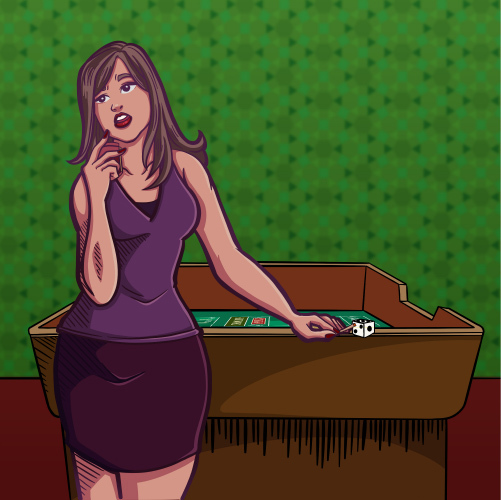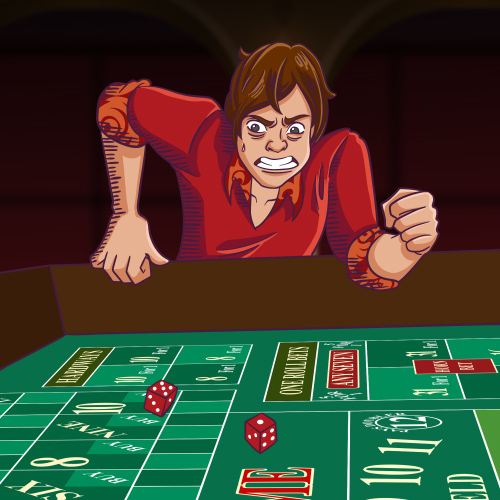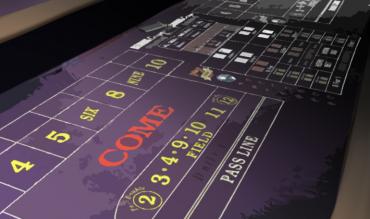Craps is the fastest and one of the most exciting casino games with over 50 bets on the layout. What follows is an explanation of the most common bets made by craps players, and the ones that are your best bets.
Pass Line
This is by far the most common bet made in craps. It is also known as a “line bet.” When the dice pass to a new shooter, craps players wagering on the pass line are hoping that the shooter will win. This occurs if the shooter:
- Rolls a 7 or 11 on the first roll (known as the come-out roll).
- Establishes a point by rolling a 4, 5, 6, 8, 9, or 10 on the come-out roll, and then rolls the point number again before a seven.
Pass-line bets lose when the shooter:
- Rolls a 2, 3, or 12 (craps numbers) on the come-out roll.
- After establishing a point number on the come-out roll, rolls a seven before rolling the point number. (The latter is known as “sevening out.”)
What determines if a craps bet is good or not depends on:
- house edge
- average cost per hour
The house edge is a percentage of each bet you make that the casino expects to win. In the case of the pass line bet, the house edge is 1.41%. The latter occurs because when you make a pass line bet, you can expect to win 49.3 percent and lose 50.7 percent of the time. In other words, the rules favor the casino winning more bets than the player, which creates its advantage.
Another way to evaluate the “worth” of a craps bet is its cost per hour. In a well-managed craps table, the dice will roll about 100 times per hour. The number of decisions that occur on the pass line is 30 per hour on average. Assuming a player makes a $5 pass line wager, the cost per hour is $5 wagered times 1.41% times 30 = $2 (rounded).
Tip: Making a pass-line bet is a smart bet to make.
Come Bet
A come bet is similar to the pass-line bet except you make it after the shooter establishes a point number on the come-out roll. The come bet has the same win/lose rules as the pass line, meaning it wins if the shooter throws a 7 or 11 on the first roll after the come bet is made and loses if a 2, 3, or 12 are rolled.
If instead, the shooter throws 4, 5, 6, 8, 9, or 10, it wins if the number is rolled again before a seven appears and loses if the shooter throws a 7 before the number.
The house edge for a come bet is the same as the pass line: 1.41%. The cost per hour is also the same: $2 (rounded) for a $5 come bet.
Tip: Making a come bet is a smart bet to make.

Odds Bet
The odds bet is the best bet in the entire casino; yet, you will not find it labeled anywhere on the craps layout. The good news is the payout odds for a winning odds bet are equal to the probability of the bet’s winning; therefore, the house edge is zero. The bad news is that you can’t make solely an odds bet; it must be made in conjunction with a pass line or come bet.
After a point number is established on the come-out roll, smart craps players will back up their pass line bet with an odds bet. For example, suppose you wager $10 on the pass line, and on the come-out roll, the shooter throws a 4 as the point number.
You can then place another $10 in chips directly behind your $10 pass line wager (representing the odds bet). The shooter will continue to roll the dice until one of two events occurs.
- A 4 is rolled before a 7, in which case both the pass line and odds bets win. The initial $10 wager is paid at 1 to 1 (you win $10) but the $10 odds wager is paid at the true odds of making the point number. (In the case of a 4, it’s 2 to 1; therefore, you win $20 for your initial $10 odds wager).
- If a seven is rolled before the 4, then the pass line and odds bets are lost.
For each point number, the payoff for the odds bet are the same as the true odds for the corresponding odds bet.
| POINT NUMBER | TRUE ODDS |
| 4 or 10 | 2 to 1 |
| 5 or 9 | 3 to 2 |
| 6 or 8 | 6 to 5 |
The odds bet lowers the total house edge on the combined pass line and odds wagers. All casinos allow single odds, but some also double, triple, ten, and up to 100-times odds. The house edge on the combined pass line plus odds wagers will decrease as the odds increase. (See table below.)
| BET | HOUSE EDGE |
| Pass Line | 1.41% |
| Pass Line + Single Odds | 0.85% |
| Pass Line + Double Odds | 0.61% |
| Pass Line + Triple Odds | 0.47% |
| Pass Line + Ten-Times Odds | 0.10% |
| Pass Line + 100-times Odds | 0.02% |
Tip: To take advantage of the odds bet, you should lower the amount of your pass-line wager in anticipation of making an odds bet. For example, suppose you wager $50 on the pass line. Your cost is:
- $50 times the 1.41 percent house edge = 70 cents.
If instead, you decrease the pass-line wager to $25 and then subsequently place $25 on the odds, the house edge on the combined $50 wagered is:
- $50 times 0.85 percent = 42 cents.
You are risking the same amount of money ($50) but at a lower cost (42 cents vs. 70 cents). Therefore, you should always take what you would have bet on the pass line, and put a percentage of it on the pass line and the rest of it on odds. If you want to increase the amount of your next bet, don’t add more chips to the pass line; instead, add them to the odds wager. That’s the smart way to take advantage of the odds bet.

Place Bets
A place bet is a bet that one of the point numbers will be rolled before the shooter rolls a seven. You can make a place bet on the 4, 5, 6, 8, 9, or 10.
Some of the latter numbers are more difficult to roll than the other numbers. Therefore, the payoffs on place bets differ from one number to another – and the house edge is different.
The following table summarizes the house edge for a place bet on each number and the cost per hour assuming a $5 place bet (except $6 on 6 and 8 to facilitate an even dollar payoff), and 100 rolls per hour. (Note: The number of decisions per hour will be slightly different, as well: 30 for the 6 and 8; 28 for the 5 and 9; and 25 for 4 and 10.)
| POINT NUMBER | TRUE ODDS | PAYOFF ODDS | HOUSE EDGE | COST PER HOUR |
| 4 or 10 | 2 to 1 | 9 to 5 | 6.67% | $8.30 |
| 5 or 9 | 3 to 2 | 7 to 5 | 4.00% | $5.60 |
| 6 or 8 | 6 to 5 | 7 to 6 | 1.52% | $2.70 |
The house edge for a place bet varies depending on the number. You’ll get the lowest house edge (1.52%) and the lowest cost per hour by making a place bet on 6 and 8.
Tip: If you want to make a Place bet, do so only on the 6 and 8.
Field Bet
The field bet is popular because of its simplicity: it’s a one-roll wager that either wins or loses. After you make a field bet it either:
- Wins if the next roll is any one of the numbers 2, 3, 4, 9, 10, 11, or 12.
- Loses if any of these four numbers are rolled: 5, 6, 7, or 8.
On the surface, the bet looks good since you win if any one of seven numbers is rolled and lose on only four numbers. However, here is the rest of the story. The four numbers that the bet doesn’t cover just happen to be the ones you are most likely to roll.
You’ll win even money if a field number is rolled but most casinos will pay double (2 to 1) on either the 2 or 12. This yields a house edge of 5.5 percent. Some more generous casinos pay double on either the 2 or 12 and triple on the other. This reduces the house edge to 2.8 percent.
The cost per hour on a $1 Field bet (assuming 100 decisions per hour and a 12 paying 3 to 1) is $2.80. If the 12 pays 2 to 1, the cost per hour increases to $5.50. The reason the cost per hour is low for the field bet is that it’s possible to bet low amounts (e.g., $1) which is not the case betting on the pass line and come. If you wager more on the field, say $5, your cost per hour would be five times greater.
Tip: If you want to make a wager on the field, do so for $1 in a casino that pays 3 to 1 for either the 2 or 12.
There are several other common craps bets, and in a future article, I’ll describe them.
